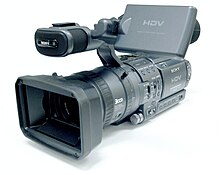High definition video
High Definition Video ( HD video forshortor HDV , English for high-resolution video ) is the generic term for high-resolution digital video formats . The term represents the current stage of development in video technology and, since its introduction, has increasingly replaced the digital video standard established in the mid-1990s.
history
From the beginning of the 21st century, camcorders were offered that offered a higher resolution than the PAL standard required (see video cameras ). The basis was the ability of the cameras to also be able to take high-resolution digital photos. Correspondingly higher quality lenses and more powerful processing processors to cope with the increased data rates were also necessary due to this photo function. High-resolution videos could thus be stored on the usual DV cassettes with the existing drives. Essentially, MPEG-2 compression was used instead of the previous DV format.
All HDV camcorders available at the time were also able to handle the “conventional” standard definition digital video format ( SD-DV ), also downwards compatible in 16: 9 . The new development of professional pure SD-DV cameras was largely stopped in 2006.
With the technical progress since 2007, HDV1 continued to spread despite certain restrictions in terms of resolution, color space and editing capabilities. In the meantime, the European Broadcasting Union has declared 720 / 50p to be its broadcast format for HDTV, which further promotes the use of 50p-capable cameras and editing systems.
With a maximum of 1440 × 1080, HDV does not correspond to the " Full HD " resolution. This afford newly developed recording formats such as AVCHD , which on the H.264 - Codec based. In addition, there are faster recording media such as hard disk drives (HDD) or memory cards , so that 1920 × 1080 pixels can also be recorded natively.
Formats
AVCHD
In the amateur camp, the AVCHD format creates non-tape-based competition: with the maximum data rate of 24 Mbit / s, recording on DV tape and thus simple archiving would theoretically be possible, but this is not intended. These "Full HD" camcorders (1920 × 1080 pixels) are only equipped with hard disk drives or memory cards. In the meantime, suitable graphics cards are also available in the amateur sector, so that processing in real time is possible. Editing systems are increasingly adapting to this new constellation and departing from the previously practiced method of software-supported video processing in such complex processes.
HDV
"HDV" is a video format for high amateur and corporate demands, but for a short time it found its way into the professional broadcast segment due to cost considerations, just as it was the case with DV at the time. The technical quality is, however, inferior to professional HD broadcast formats such as DVCPRO-HD or HDCAM , whose data rates are four or sixteen times as high and work with higher color sampling. Such a development is XDCAM HD of Sony that in three different data rates of 18, 25, 35 Mbit / s and 50 Mbit / s (XDCAM HD 422) is working and also on a MPEG-2 - Codec based.
4K2K
4K2K is a digital high-definition video format that is roughly four times the resolution of HDTV.
UHDTV
Ultra High Definition Television is a digital high definition video format that is approximately sixteen times the resolution of HDTV.
See also
literature
- Ulrich Stöckle: HD ready or what? Tips for switching to HDTV. bhv PRAXIS, 2006, ISBN 978-3-8266-7437-2 .
- W. Wunderlich: Digital television HDTV, HDV, AVCHD for beginners and those switching. Auberge-tv Verlag, Hohen Neuendorf 2007, ISBN 978-3-00-023484-2 .
Web links
- HDTV - an introduction. In: MORIJA media

